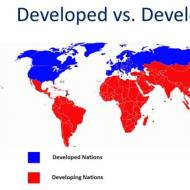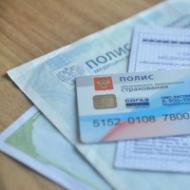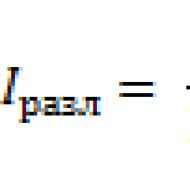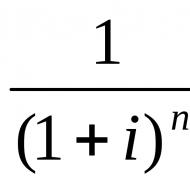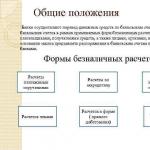
Tax on property acquired in the year. Movable property: nuances of taxation. For Russian organizations
Corporate property tax is paid exclusively by firms. It does not apply to entrepreneurs.
The property tax of organizations is established by Chapter 30 of the Tax Code. This tax is enforced by regional law. If there is no such law in your region, you do not need to pay tax.
Taxpayers
Organizational property tax paid exclusively by companies. It does not apply to entrepreneurs. Moreover, taxpayers are only companies that have property recognized as an object of taxation, that is, taken into account on the balance sheet as fixed assets. Accordingly, if the company does not have such property, then there is no need to submit tax returns to the inspectorate (we recall that previously in such cases it was necessary to submit “zero” returns).
Some types of businesses are exempt from tax. In particular, tax is not paid:
- public organizations of disabled people (in which 80 percent or more of disabled people work);
- companies whose authorized capital consists entirely of contributions from public organizations of disabled people. In this case, the benefit is valid if the company employs at least 50% of disabled people, and their salary is at least 25% of the total wage fund. Moreover, the property of such companies should not be used for the production and sale of excisable goods, mineral raw materials, minerals, as well as other goods specified in the Decree of the Government of the Russian Federation of February 18, 2004 No. 90;
- firms whose sole owners of property are all-Russian public organizations of disabled people - in relation to property used for the needs of culture and art, education, physical culture and sports, healthcare and social security for disabled people. In particular, these may be:
- educational institutions;
- medical institutions;
- recreational sports camps and labor and recreation camps;
- centers, clubs and circles in the field of education;
- specialized prosthetic and orthopedic enterprises;
- bar associations, law offices and legal consultations;
- state scientific centers.
Object of taxation
Firms must pay property tax on the residual value of fixed assets.
Fixed assets include property that the company uses as a means of labor for more than one year (for example, buildings, equipment, computer equipment, vehicles, etc.) or rents out.
The residual value of such property is calculated as follows:
Residual value of fixed assets
www.buhgalteria.ru
Since 2013, only real estate is subject to property tax. How are these changes implemented in programs?
Since 2013, only real estate is subject to property tax. How are these changes implemented in 1C programs?
1. In the report “Property Tax Advances”, the residual value of fixed assets received in the 1st quarter of 2013 is not taken into account. Why?
2. Should the value of property accepted for accounting after 01/01/2013 be reflected in the regulated report “Property Tax Advances” for 1 sq. 2013 (section 2, lines 020-050, column 4 “including the cost of preferential property”)?
3. Is it true that in 1C programs, when calculating property tax, only property included in the following groups is taken into account: Structures, Perennial plantings, Land plots, Other property requiring state registration, Natural resources. If so, why?
On January 1, 2013, the changes made to Chapter 30 “Property Tax of Organizations” of the Tax Code of the Russian Federation by Federal Law No. 202-FZ of November 29, 2012 came into force. According to one of the amendments, movable property registered as a fixed asset on January 1, 2013 is not subject to property tax.
In the 1C: Accounting 8 program, whether property is movable or immovable is determined by the OS group in which it is included. The group is specified manually in the fixed asset card.
- other objects requiring state registration and classified by Article 130 of the Civil Code of the Russian Federation as real estate.
Property classified into the following groups is considered movable:
— machinery and equipment (except office equipment);
— production and household equipment;
— capital investments in leased property;
— other types of fixed assets.
In addition to the group for the fixed asset, you must specify its type: The main thing or Capital investments in leased real estate. If type is selected Capital investments., then the cost of the fixed asset will be taken into account when forming the property tax base, regardless of the group and date of acceptance of the object for accounting. Such changes to the program were made in accordance with the letter of the Ministry of Finance of Russia dated March 14, 2013 No. 03-05-05-01/7760. Document screen forms Fixed assets in the program "1C: Accounting 8" editions 2.0 and 3.0 - see below.

Amendments to the legislation have caused changes in the algorithms for auto-completion of regulated reports Tax calculation for advance payment of corporate property tax And Declaration on property tax of organizations. From 01/01/13, when filling out these reports, data is processed on all fixed assets accepted for accounting before January 1, 2013, and on all real estate objects accepted for accounting starting from January 1, 2013. The date of acceptance for accounting is determined by the date of the document Acceptance of fixed assets for accounting.
In order for the reports to be filled out correctly, for each fixed asset received in 2013, you need to check the group to which it is assigned and select the OS type.
Property tax: innovations - 2018
From January 1, 2018, movable property again became the object of taxation. Corresponding changes to the legislation were made by Federal Law No. 335-FZ dated November 27, 2017.
Let us recall that before 2018, legal entities were exempt from paying movable property tax on objects registered as fixed assets after January 1, 2013.
From January 1, 2018, according to the new version of Art. 380 of the Tax Code of the Russian Federation and Art. 381.1 of the Tax Code of the Russian Federation, the tax benefit on movable property of organizations belonging to 3–10 depreciation groups no longer applies. However, according to Art. 381.1 Tax Code of the Russian Federation,
“The law of a constituent entity of the Russian Federation in relation to the property specified in paragraph 25 of Article 381 of the Tax Code of the Russian Federation, from the date of issue of which no more than 3 years have passed, as well as property classified by the law of a constituent entity of the Russian Federation as innovative high-performance equipment, may establish additional tax benefits up to complete exemption such property from taxation.”
Thus, in the territories of different regions of Russia, various benefits may apply in relation to movable property other than that acquired from related parties and received during liquidation or reorganization - depending on the legislation of the subject. However, the list of property in respect of which a subject of the Russian Federation can make decisions on benefits is limited - benefits can only be established in relation to property, from the date of issue of which no more than 3 years have passed, as well as in relation to innovative equipment. However, no restrictions are imposed on the amount of benefits.
Subjects of the Russian Federation can also regulate the timing of payment of advance payments and movable property tax. Therefore, timing may vary in different regions.
As for the rates for movable property tax, then, according to clause 3.3 of Art. 380 of the Tax Code of the Russian Federation, in 2018 the maximum tax rate on movable property should not exceed 1.1%. From 2019, the maximum rate will be doubled – to 2.2%.
It should be noted that enterprises operating under the simplified tax system are still exempt from property tax (including movable property) in 2018. For companies using the simplified tax system, the object of taxation is exclusively real estate that has a cadastral value at the beginning of the tax period.
As for other legal entities - owners of movable property, when calculating tax, one should be guided by regional legislation.
Thus, in the territory of St. Petersburg, the benefit was retained for movable property, the date of issue of which no more than three years have passed. The remaining movable property will need to pay tax at a rate of 1.1%. (Article 1, Law of St. Petersburg dated November 29, 2017 No. 785-129 “On amendments to certain laws of St. Petersburg on taxes and fees” (adopted by the Legislative Assembly of St. Petersburg on November 29, 2017))
The Moscow authorities have not yet adopted a law defining benefits for movable property. Therefore, all capital taxpayers must tax movable property at a rate of 1.1% (with the exception of property tax on cadastral value).
As for the Moscow region, the tax rate on movable property from 2018-2020 is 0%. (Law of the Moscow Region dated October 3, 2017 No. 159/2017-OZ)
Also, the benefit for movable property has been preserved on the territory of the Chechen Republic (Law of the Chechen Republic dated November 27, 2017 No. 45-RZ). On the territory of the Ivanovo and Lipetsk regions (Law of the Ivanovo Region dated December 11, 2017 No. 94-OZ, Law of the Lipetsk Region dated September 14, 2017 No. 106-OZ) the benefit was extended until the end of 2018.
However, of course, these benefits are established by subjects taking into account the restrictions that the Tax Code imposes on their powers - namely, only in relation to property, from the date of issue of which no more than 3 years have passed, as well as in relation to innovative equipment.
At the end of the article, I would like to emphasize that the above changes apply only to movable property of organizations belonging to 3–10 depreciation groups. Fixed assets of depreciation groups 1 and 2 are still exempt from taxation (clause 8, clause 4, article 374 of the Tax Code of the Russian Federation).
The algorithm for calculating property tax in 2018 has changed significantly. Movable property again became the object of taxation. In order to correctly determine the property tax base, it is necessary to use not only the norms of the Tax Code of the Russian Federation, but also the relevant laws of the constituent entities of the Russian Federation.
www.ascon-spb.ru
Organizational property tax - changes from 2018
Let's consider current changes in tax legislation, namely changes in the property tax of organizations.
The federal tax benefit on movable property has become regional
How it was in 2017
Fixed assets of 1-2 depreciation groups were not subject to taxation (clause 8, paragraph 4, article 374 of the Tax Code of the Russian Federation, Classification of fixed assets, approved by Decree of the Government of the Russian Federation of 01.01.2002).
Fixed assets of 3–10 depreciation groups, regardless of the date of their registration, were subject to taxation. However, in most cases it was not necessary to include their value in the tax base until 2018.
Since, according to paragraph 25 of Article 381 of the Tax Code of the Russian Federation, a federal benefit was provided for movable property registered as fixed assets from January 1, 2013. The exception was movable fixed assets received during reorganization, liquidation, or from interdependent persons.
For fixed assets of 1–2 depreciation groups, everything remains as before - they do not belong to the objects of taxation (clause 8, clause 4, article 374 of the Tax Code of the Russian Federation).
And with regard to movable property included in other depreciation groups and accepted for accounting since 2013, the taxation procedure is changing.
As of January 1, 2017, Chapter 30 of the Tax Code of the Russian Federation was supplemented with a new article 381.1, according to which the federal property tax benefit in respect of the property specified in paragraph 25 of Article 381 of the Tax Code of the Russian Federation (movable property accepted for registration on January 1, 2013), with 01/01/2018 is valid on the territory of a constituent entity of the Russian Federation only subject to the adoption of the relevant law of the constituent entity.
Amendments to the Tax Code of the Russian Federation were introduced by Federal Law dated November 30, 2016 N 401-FZ.
Also, from January 1, 2018, Article 381.1 of the Tax Code of the Russian Federation was supplemented with paragraph 2 (Federal Law dated November 27, 2017 N 335-FZ). According to which the law of the subject has the right to establish additional tax benefits up to complete tax exemption in relation to:
- Property classified by the law of a constituent entity of the Russian Federation as innovative, highly efficient equipment;
- Movable property specified in paragraph 25 of Article 381 of the Tax Code of the Russian Federation, from the date of issue of which no more than 3 years have passed.
Many constituent entities of the Russian Federation did not consider it necessary to “extend” the benefit at the regional level. Therefore, legislators decided to limit the tax rate on such property for 2018.
If the regional law does not establish benefits in relation to movable property specified in paragraph 25 of Article 381 of the Tax Code of the Russian Federation, tax rates in respect of such property cannot exceed 1.1% in 2018 (clause 3.3 of Article 380 of the Tax Code of the Russian Federation as amended).
At the same time, the limitation on the tax rate (within 1.1%) also does not apply, i.e. such property is taxed in accordance with the generally established procedure (clause 3.3 of Article 380 of the Tax Code of the Russian Federation)
In some regions, relevant laws have been adopted in relation to preferential movable property, allowing you not to pay tax in 2018, or to pay at a rate lower than 1.1%.
Among them is the Moscow region. Law of October 3, 2017 No. 159/2017-OZ for the period 2018 - 2020. a zero tax rate has been established for movable property accepted by an organization for registration as fixed assets since January 1, 2013. The law lists exceptions established by the Tax Code of the Russian Federation in respect of which the 0% rate does not apply: objects registered as a result of the reorganization of legal entities, when transferring property between interdependent persons, etc.
And companies located in St. Petersburg, in 2018, apply the benefit only to movable property, from the date of issue of which no more than 3 years have passed (Law of St. Petersburg dated November 29, 2017 No. 785-129).
Therefore, in relation to movable property of 3 - -10 depreciation groups, issued and accepted for accounting in 2013-2014, the benefit does not apply in 2018. Since the region has not established its own tax rate, a preferential maximum rate of 1.1% will apply to such property.
No amendments were made to Moscow Law dated November 5, 2003 No. 64 “On Organizational Property Tax” to allow the use of the benefit under paragraph 25 of Article 381 of the Tax Code of the Russian Federation in 2018. Consequently, for Moscow organizations, movable property of 3-10 depreciation groups, registered since 2013, is now subject to property tax at a maximum preferential rate of 1.1%.
The maximum tax rate for movable property registered on January 1, 2013 is 1.1%. When applying the benefit in 2018, you must carefully study the law of your constituent entity of the Russian Federation on corporate property tax.
Benefits for energy-efficient facilities are also “transferred” to the regions
On January 1, 2018, amendments to Art. 381.1 of the Tax Code of the Russian Federation, introduced by Federal Law of September 30, 2017 N 286-FZ. “Thanks to” them, the benefit provided for in paragraph 21 of Article 381 of the Tax Code of the Russian Federation (facilities with high energy efficiency) is given to the regions. Those. if a subject of the Russian Federation has not established by the relevant law the possibility of applying benefits in relation to these objects, from 01/01/2018 they are taxed in the generally established manner.
Calculation of property tax on real estate
The specifics of calculating tax amounts and advance payments, if the tax base is determined as the cadastral value of real estate, are given in paragraph 12 of Article 378.2 of the Tax Code of the Russian Federation.
From January 1, 2018, the specifics of determining the tax base, calculation and payment of tax in relation to certain objects of real estate of organizations if their cadastral value is determined during the year have been clarified (Federal Law of September 30, 2017 N 286-FZ, paragraph 12 of Article 378.2 is supplemented by subparagraph 2.1) .
We are talking about real estate of foreign organizations that do not carry out activities in Russia through permanent representative offices and about real estate of foreign organizations that are not related to their activities in Russia through permanent representative offices. And also about residential buildings and residential premises that are not taken into account on the balance sheet as fixed assets in accordance with PBU 6/01.
If the cadastral value of the specified real estate was determined during the year, then the tax base and calculation of the amount of tax (advance payment) for the current year in relation to these objects is determined based on the cadastral value established on the day of entering information into the Unified State Register of Real Estate, which is the basis for determining the cadastral value of such property. object.
The tax return for 2017 is submitted using a new form
Starting with the submission of the declaration for 2017, organizations need to use a new form of declaration and calculation of the advance payment, as well as new procedures for filling out reports and formats for submitting documents electronically, approved. By order of the Federal Tax Service of Russia dated March 31, 2017 N ММВ-7-21/271@.
Let us recall that for the reporting periods of 2017, organizations could submit calculations for advance tax payments using the form approved. By Order of the Federal Tax Service of Russia dated March 31, 2017 N ММВ-7-21/271@, and according to the old form, approved. by order of the Federal Tax Service of Russia dated November 24, 2011 N ММВ-7-11/895 (letter of the Federal Tax Service of Russia dated June 23, 2017 N BS-4-21/12076).
So, the main changes in 2018 are related to the abolition of the federal benefit for movable property. Now the authorities of each subject independently decide whether to tax the specified assets of companies or not.
pravovest-audit.ru
Property tax rates in 2013.
Previously, we reported that the Moscow City Duma adopted the Law “On Amendments to Article 1 of the Moscow City Law of October 23, 2002 No. 47 “On Personal Property Tax Rates.”
Moscow Law No. 56 dated November 14, 2012 established new tax rates on the property of citizens (which belongs to them by right of ownership) starting January 1, 2013. The tax is calculated based on the inventory value of the property.
Tax rates in Moscow:
In the territories included in the territory of Moscow as a result of changes in the city border, property tax rates are as follows:
Taking into account the average inventory value of 500-600 thousand rubles, the average tax rate will be 3,000-3,600 rubles. (in a year).
If the inventory value of the apartment (this applies to large apartments) exceeds 1 million rubles, the tax (minimum) rate will be 7,500 rubles. (in a year).
It should be noted that the inventory value of new buildings is approximately equal to their market value.
A certificate of inventory value can be obtained by the owner of the apartment or his representative in the BTI authorities, where the inventory value of housing is calculated by BTI employees using the formula:
C = C * (1 -Iphys,/100 * Ci),
where C is the inventory value of the valued object (thousand rubles);
C - replacement cost of a residential building (that is, the amount of costs in the form of depreciation charges necessary to restore the deterioration of the object) (thousand rubles);
I - indicators of physical deterioration of a residential building (%);
K is the coefficient of differentiation of objects.
Tax on the sale of real estate since 2016. — see here.
From January 1, 2015, the procedure for taxing movable property with property tax is changing. We will analyze how innovations will affect the tax burden of organizations using specific examples.
In one of the articles we commented on the changes introduced by the so-called “tax maneuver” law by Federal Law No. 366-FZ of November 24, 2014 “On amendments to part two of the Tax Code of the Russian Federation and certain legislative acts of the Russian Federation.”
The issue concerning innovations regarding the calculation of property tax on movable fixed assets deserves special attention.
Let us briefly recall the rules for calculating property tax in 2014 in relation to movable objects. Movable property registered as part of fixed assets on January 1, 2013 is not subject to taxation (clause 8, clause 4, article 374 of the Tax Code of the Russian Federation). At the same time, the origin of such movable property did not matter (obtained during the reorganization process, identified during inventory in the form of surplus, etc.).
Starting from January 1, 2015, this norm is set out in a new edition. According to the updated version of clause 8, clause 4, article 374 of the Tax Code of the Russian Federation fixed assets included in depreciation groups I - II(in accordance with the Classification of fixed assets, approved by Decree of the Government of the Russian Federation dated January 1, 2002 No. 1 are not subject to property taxation.
Let us recall that the first depreciation group includes all short-lived property with a useful life of 1 to 2 years inclusive (for example, tools for metalworking and woodworking machines, jackhammers, hand and mechanized construction and installation tools, cable communications equipment).
The second depreciation group includes property with a useful life of more than 2 years up to 3 years inclusive (for example, technological equipment for mechanical engineering, electronic computer equipment, including personal computers and printing devices, servers, network equipment of local computer networks).
That is, such property is not subject to taxation from January 1, 2015. Moreover, the property can be accepted for accounting before 01/01/2013. It should be noted that property of depreciation group I accepted for accounting before 01/01/2013 as of 01/01. 2015 has zero residual value.
Does this mean that property tax must be assessed on the remaining property?
The amendment made to paragraph 8, paragraph 4, Article 374 of the Tax Code of the Russian Federation cannot be considered in isolation from the new paragraphs 25 and 26 of Article 381 of the Tax Code of the Russian Federation, which provide.
So, from January 1, 2015 Movable property is exempt from property tax organizations, registered on January 1, 2013 as fixed assets, with the exception of receiving such objects during reorganization, liquidation of an organization, as well as from interdependent persons (clause 25 of Article 381 of the Tax Code of the Russian Federation).
Thus, movable property belonging to the III-X depreciation group, accepted for accounting in the above situations in 2013–2014, falls under.
In addition, from January 1, 2015 property is exempt from property tax organization taken into account on the balance sheet of the organization - participant of the free economic zone, created or acquired for the purpose of conducting activities in the territory of a free economic zone and located on the territory of this free economic zone, for ten years from the month following the month of registration of the specified property (clause 26 of Article 381 of the Tax Code of the Russian Federation).
The innovations concern property recorded in the territory of the Crimean Federal District, the Republic of Crimea and the federal city of Sevastopol.
The procedure for calculating tax on movable property (for property received during reorganization, liquidation of organizations, as well as from interdependent persons)
Let us recall that the norms of civil legislation (Articles 57 and 58 of the Civil Code of the Russian Federation) define five forms of reorganization of a legal entity: merger, accession, division, separation, transformation.
If an organization received movable property from a reorganized or liquidated organization, then it was not subject to property tax in 2013–2014. by virtue of clause 8, clause 4, article 374 of the Tax Code of the Russian Federation. Numerous explanations from the financial department confirmed this approach (Letters of the Ministry of Finance of the Russian Federation dated November 13, 2013 No. 03-05-05-01/48376, dated September 25, 2013 No. 03-05-05-01/39723, dated August 12, 2013 No. 03-05-05-01/32638, dated 08/05/2013, No. 03-05-05-01/31412, dated 07/03/2013, No. 03-05-05-01/25477).
In practice, the reorganization of organizations was often carried out with the aim of saving on property taxes.
The “old” edition of Chapter 30 of the Tax Code of the Russian Federation also did not provide for any restrictions regarding the possibility of removing it from the object of taxation when receiving movable property from interdependent persons (individuals or legal entities).
That is, the legal successor (or interdependent person) of movable property from 01/01/2015 is obliged to pay as for previously received (in 2013-2014) movable property as a result of reorganization, liquidation of the organization, from interdependent persons (which was not subject to property tax) , and for acquired property in these cases in 2015, with the exception of property of depreciation groups I-II.
The procedure for calculating tax, effective from January 1, 2015 for such categories of taxpayers, is systematized in the table:
|
I-II depreciation group |
III-X depreciation group |
|
|
They are subject to property tax on a general basis (clause 1 of Article 374 of the Tax Code of the Russian Federation), i.e. the benefit does not apply to such property (clause 25 of article 381 of the Tax Code of the Russian Federation). |
||
Example No. 1.
The organization Buttercup LLC was created by spinning off from Tsvetochek LLC. On the balance sheet of the reorganized Tsvetochek LLC there is a vehicle - a car classified as the third depreciation group in accordance with the Classification of fixed assets.
The car is transferred to the allocated organization according to the separation balance sheet. The separate organization LLC “Lutik” was registered on March 30, 2013.
LLC "Lutik" in 2013-2014. did not include in the object of property taxation the residual value of the car accepted on the basis of the separation balance sheet. However, starting from January 1, 2015, the organization is obliged to charge property tax (and, accordingly, advance tax payments) on the under-depreciated part of the car.
At the same time, the organization does not have an obligation to submit updated property tax returns for 2013-2014, since the adopted norm, which worsens the taxpayer’s position, does not have retroactive effect (clause 2 of Article 5 of the Tax Code of the Russian Federation).
The innovations also apply to transactions carried out by related parties related to the transfer, including the acquisition, of movable property. Interdependence between organizations is determined according to the rules of Article 105.1 of the Tax Code of the Russian Federation, which establishes 11 grounds for recognizing organizations as interdependent. Thus, interdependent persons, in particular, include (clause 2 of Article 105.1 of the Tax Code of the Russian Federation) organizations if the share of participation of one organization in another organization is more than 25% (this takes into account the share of not only direct participation, but also participation through interdependent persons).
In relation to the “employer-employee” structure, interdependence occurs if:
- the employee directly or indirectly participates in the organization with a participation share of more than 25%;
- the employee has the authority to appoint the sole executive body of the organization or to appoint at least 50% of the collegial body or board of directors;
- the employee exercises the powers of the sole executive body of the organization;
- the share of direct participation of each previous person in each subsequent organization is more than 50%.
Example No. 2.
In 2013, the organization Tsvetochek LLC donated a car to its subsidiary organization Buttercup LLC. The share of direct participation of Tsvetochek LLC in the authorized capital of Buttercup LLC is more than 25%.
LLC "Lutik" in 2013-2014. did not include in the object of property taxation the residual value of the car accepted on the balance sheet.
However, starting from January 1, 2015, the organization is obliged to charge property tax (and, accordingly, advance tax payments) on the under-depreciated part of the car, since movable property belongs to the third depreciation group.
The organization has no obligation to submit updated returns for past tax periods.
In relation to transferred movable property belonging to depreciation groups I-II, the previously valid rules still apply.
Example No. 3.
Let's change the conditions of the previous example. Let us assume that the subsidiary received from the parent organization movable property of depreciation groups I-II.
LLC "Lutik" will not include the residual value of movable property accepted on the balance sheet as an object of property taxation.
It should be noted that such property is not recognized as preferential property (clause 25 of Article 381 of the Tax Code of the Russian Federation) and, accordingly, is not subject to reflection in the tax return (calculation of advance payment of tax) with code 2010257.
Procedure for calculating tax on movable property (for other categories of taxpayers)
Now let's look at the new rules, effective from January 1, 2015, for the remaining category of taxpayers:
|
Period of acceptance of movable property for registration |
Movable property related to |
|
|
I-II depreciation group |
III-X depreciation group |
|
|
Not subject to property tax on the basis of clause 8, clause 4, article 374 of the Tax Code of the Russian Federation, i.e. are not subject to taxation. |
They are subject to property tax on a general basis (clause 1 of Article 374 of the Tax Code of the Russian Federation). |
|
|
Not subject to property tax on the basis of clause 25 of Article 381 of the Tax Code of the Russian Federation, i.e. are a tax benefit. |
||
Example No. 4.
The organization LLC "Lutik" has fixed assets on its balance sheet, which are distributed into the following depreciation groups:
Depreciation group number
Date of acceptance of property for registration
Residual value of movable property by condition
as of 01/01/2015
as of 02/01/2015
As of 03/01/2015
as of 04/01/2015
Until 01/01/2013
After 01/01/2013
Until 01/01/2013
After 01/01/2013
Let's calculate the amount of the advance payment for property tax for the first quarter of 2015 (clause 4 of article 376 of the Tax Code of the Russian Federation, clause 4 of article 382 of the Tax Code of the Russian Federation).
1 step. Determination of the value of property not subject to taxation.
Such property includes property accepted for accounting before 01/01/2013 of I-II depreciation groups:
100,000 rub. + 90,000 rub. + 80,000 rub. + 70,000 rub. = 340,000 rub.
The residual value of such property is excluded from the object of taxation
Step 2. Calculation of the average cost of preferential property.
Such property includes movable property accepted for accounting from 01/01/2013 of depreciation group I-X:
(RUB 2,000,000 + RUB 1,800,000 + RUB 1,600,000 + RUB 1,400,000 + RUB 1,000,000 + RUB 850,000 + RUB 800,000 + RUB 700,000) / 4 = 2 RUB 537,500
Step 3. Calculation of the average value of taxable property:
(500,000 rub. + 400,000 rub. + 300,000 rub. + 200,000 rub.) / 4 = 350,000 rub.
Step 4 Calculation of advance payment for property tax:
350,000 rub. x 2.2% / 4 = 1,925 rub.
When filling out a declaration (advance calculation) for property tax, starting from I quarter 2015, you should take into account the explanations of the tax department given in the letter of the Federal Tax Service of the Russian Federation dated December 12, 2014 No. BS-4-11/25774. The letter states that before official changes are made to the order of the Federal Tax Service of the Russian Federation dated November 24, 2011 No. ММВ-7-11/895 “On approval of forms and formats for electronic submission of tax returns and tax calculations for advance payment of property tax of organizations and procedures for filling them out" when filling out tax returns for property tax of organizations, starting with the tax and reporting periods of 2015, by taxpayers claiming the right to a benefit under clause 25 of Art. 381 of the Tax Code of the Russian Federation, by line with code 160 section 2 tax return for property tax of organizations (tax calculation for advance payment), filled out code 2010257.
And taxpayers claiming the right to benefits under clause 26 of Art. 381 of the Tax Code of the Russian Federation (in relation to property recorded on the balance sheet of an organization participating in a free economic zone Crimean Federal District, in the territories of the Republic of Crimea and the federal city of Sevastopol, for ten years from the month following the month of registration of the specified property), according to the line with code 130 section 2 tax return for tax (tax calculation for advance payment), filled out in relation to the specified property, must be indicated assigned to this tax benefit code 2010258.
Summarizing
On the one hand, the changes are aimed at countering schemes for avoiding taxation of movable property in relation to reorganized, liquidated companies, as well as interdependent persons.
On the other hand, despite the fact that for the rest of the category of taxpayers there have been no global changes, not counting the possibility of removing from the object of taxation the residual value of fixed assets accepted for accounting before 01/01/2013 (belonging to depreciation groups I - II) , the following point must be taken into account.
As noted, movable objects will be moved to a preferential category, with the appropriate code assigned to reflect them in the tax return (tax calculation for the advance payment of property tax). What does this mean in practice? Let us remind you that when conducting a desk tax audit, taxpayers are required to submit documents confirming their right to tax benefits (clause 6 of Article 88 of the Tax Code of the Russian Federation). The mechanism for requesting documents from tax authorities regarding the application of tax benefits is discussed in paragraph 14 of Resolution of the Plenum No. 33 of May 30, 2014.
In paragraph 14 of Plenum No. 33 it is noted that when applying this norm it is necessary to use the concept of “tax benefit” in the sense given in paragraph 1 of Art. 56 Tax Code of the Russian Federation. And according to paragraph 1 of Art. 56 of the Tax Code of the Russian Federation, tax benefits are recognized as advantages provided to certain categories of taxpayers compared to other taxpayers. That is tax authorities when conducting a desk audit of a tax return (advance calculation) for property tax, he has the right to request documents confirming benefits (primarily, these are acts of acceptance and transfer of fixed assets).
Due to the changes made the taxpayer must organize separate accounting movable property in the following groups:
- property that is not recognized as an object of taxation;
- preferential property;
- property subject to taxation.
Since 2013, changes have been made to Chapter 30 “Organizational Property Tax” of the Tax Code of the Russian Federation. Let's consider the main of these changes.
1. Movable property is not recognized as an object of taxation.
In accordance with paragraphs. 8 clause 4 art. 374 of the Tax Code of the Russian Federation, from January 1, 2013, movable property registered as fixed assets is not subject to property tax for organizations. Movable property is all office equipment, cars, equipment, furniture of the organization, etc. This provision applies to movable property registered starting from January 1, 2013. All movable property that was registered earlier than this date will continue to be subject to taxation until its original cost is completely written off in accounting, or until sale (other disposal).
It should be noted that organizations are required to timely take into account fixed assets and reflect them on balance sheet accounts 01 “Fixed Assets” and 03 “Profitable Investments in Material Assets”.
NEW PROCEDURE FOR PAYING PROPERTY TAX ON MOVABLE PROPERTY
In accordance with Order of the Ministry of Finance of the Russian Federation dated October 31, 2000 N 94n (as amended on November 8, 2010) “On approval of the Chart of Accounts for accounting financial and economic activities of organizations and Instructions for its application,” the balance on account 08 “Investments in non-current assets” can only reflect the amount of the organization’s investments in construction in progress, unfinished transactions for the acquisition of fixed assets, intangible and other non-current assets.
Thus, movable property objects that do not require installation must be put into operation immediately after their acquisition. If for objective reasons this does not happen, the organization must have primary documents that provide a clear list of work to prepare the facility for use.
From 2013, all movable property of an organization will be divided into those that are subject to property tax and those that are not subject to taxation. It is advisable to open two sub-accounts for movable property accounts: for objects registered before 2013, and for objects registered after 2013.
ACCOUNTING SERVICES, PRICE
Primary documents confirming the moment of acceptance of movable property for accounting may be acts of acceptance - transfer of fixed assets and inventory cards. The organization must develop these documents independently and approve them in its accounting policies for 2013.
It should be noted that organizations can approve in their accounting policies the unified forms N OS-1 “Act of acceptance and transfer of fixed assets (except buildings, structures)” and N OS-6 “Inventory card for recording fixed assets” previously adopted by the State Statistics Committee of the Russian Federation. (Resolution of the State Statistics Committee of the Russian Federation dated January 21, 2003 N 7 “On approval of unified forms of primary accounting documentation for accounting of fixed assets”).
TAXATION OF SERVICES OF A FOREIGN ORGANIZATION FROM A RUSSIAN CONTRACTOR
2. The list of property not recognized as objects of taxation has been expanded.
Starting from 2013, the following are also not recognized as subject to corporate property tax:
- objects recognized as objects of cultural heritage (historical and cultural monuments) of the peoples of the Russian Federation of federal significance (clause 3, clause 4, article 374 of the Tax Code of the Russian Federation);
- nuclear installations for scientific purposes, storage facilities for nuclear materials and radioactive substances and radioactive waste storage facilities (clause 4, clause 4, article 374 of the Tax Code of the Russian Federation);
- icebreakers, ships with nuclear power plants and nuclear technology service ships (clause 5, clause 4, article 374 of the Tax Code of the Russian Federation);
- space objects (clause 6, clause 4, article 374 of the Tax Code of the Russian Federation);
- ships registered in the Russian International Register of Ships (clause 7, clause 4, article 374 of the Tax Code of the Russian Federation).
3. Maximum tax rates have been established for public railways, main pipelines and power lines.
In accordance with paragraph 3 of Art. 380 of the Tax Code of the Russian Federation, from January 1, 2013, in relation to public railway tracks, main pipelines, energy transmission lines, as well as structures that are an integral technological part of these objects, a maximum tax rate was established, which is lower than the rates for other property. In 2013, tax rates on this property cannot exceed 0.4 percent, in 2014 - 0.7 percent, in 2015 - 1.0 percent, in 2016 - 1.3 percent, in 2017 - 1. 6 percent, in 2018 - 1.9 percent.
In accordance with paragraph 4 of Art. 380 of the Tax Code of the Russian Federation, if the law of a subject of the Russian Federation does not determine the tax rate in relation to these objects, then taxation will be carried out at the marginal tax rate established by clause 3 of Art. 380 Tax Code of the Russian Federation.
CONTROVERSIAL ISSUES REGARDING PROPERTY TAX
The list of property related to the specified objects must be approved by the Government of the Russian Federation. At the time of writing, the corresponding document has not been adopted.
The tax authorities and the Ministry of Finance of Russia in their joint letter (Letter of the Federal Tax Service of Russia dated December 13, 2012 N BS-4-11/21285@ “On the property tax of organizations” (together with the Letter of the Ministry of Finance of Russia dated December 11, 2012 N 03- 05-04-01/44)) explained that until the approval of the new list, one should be guided by the List approved by Decree of the Government of the Russian Federation of September 30, 2004 (as amended on October 6, 2011) N 504 “On the list of property relating to public railways, public federal roads, main pipelines, energy transmission lines, as well as structures that are an integral technological part of these objects, in respect of which organizations are exempt from corporate property tax.”
rosco.su
The Tax Service, in Letter No. BS-4-11/26159 dated December 17, 2014, indicated new codes for property tax benefits for organizations and legal entities. These codes are reflected in Appendix No. 6 to the Procedure for filling out the declaration.
Benefits: release of a certain fixed asset; preferential rate of fixed assets; a decrease in the tax amount of a certain fixed asset in the property tax return is reflected in lines 160, 200 or 240 of section 2 or 040, 070 or 120 of section 3.
Property tax benefit code 2010257
Fixed assets accepted and put into operation in any organization on the basis of ownership become subject to taxation.
Benefit code 2010257 is taken into account in tax calculations for advance payments from January 1, 2015, since no change was made to the declaration, the Federal Tax Service clarified the application of the benefit in a letter dated December 2, 2014 No. BS-4-11/25774@.
Until January 2015, movable property accepted as fixed assets on January 1, 2013 is not recognized as an object of taxation for property tax (subclause 8 of clause 4 of Article 374 of the Tax Code of the Russian Federation). The exception is the OS obtained as a result of:
- liquidation of a company or reorganization of a legal entity;
- acquisition, transfer of property between related parties, except for trains produced after January 1, 2013 from 2017.
The application of the benefit (clause 25 of Article 381 of the Tax Code of the Russian Federation) since 2018 depends on the decision to apply the benefit in the region, in accordance with Article 381.1 of the Tax Code of the Russian Federation.
The tax benefit code for corporate property tax – 2010257 is shown in Section 2 on line 160 of the tax calculation for advance payments.
Get 267 video lessons on 1C for free:
- Free video tutorial on 1C Accounting 8.3 and 8.2;
- Tutorial on the new version of 1C ZUP 3.0;
- Good course on 1C Trade Management 11.
The ability to apply tax benefits (federal, regional) does not relieve one from the obligation to submit a property tax return to the tax service, in accordance with Order of the Federal Tax Service of November 24, 2011 N ММВ-7-11/895.
The basis for using benefit 2010257 in an organization are acts of acceptance and transfer of fixed assets and an inventory card for property, confirming the data on movable property recorded on the balance sheet.
Tax benefit code 2010257 does not apply
The tax benefit cannot be applied to fixed assets that are not included in the first and second depreciation groups. When calculating the average annual value of property for 2016 -2017. The cost of operating systems included in groups 3-10 is taken into account.
Also, when calculating the average annual value of property, the following are not taken into account:
- fixed assets having a residual value and accepted for accounting before January 1, 2013;
- non-depreciated fixed assets accepted for accounting by an organization in the period 2013-2014 as a result of the liquidation or reorganization of a legal entity.
Using benefit 2010257 as an example
Let us consider in more detail the use of benefit code 2010257 for corporate property tax as an example.
Residual value of fixed assets in the organization on the first day of each month of the reporting period for which a property declaration is drawn up:
The tax rate for an organization is 2.2%
Let's do the calculation:
- the average cost of fixed assets for the six months is 1,590,000 rubles. (1,650,000 +1,630,000 + 1,610,000 + 1,590,000 + 1,570,000 + 1,550,000 + 1,530,000) /7;
- the average cost of preferential property for the six months is 690,000 rubles. (720,000 + 710,000 + 700,000 + 690,000 + 680,000 + 670,000 + 660,000)/7;
- the amount of the advance payment for the six months is 19,800 rubles. (1,590,000 - 690,000) * 2.2%.
A sample of filling out a property tax return using benefit 2010257 is attached in Excel and PDF format.
BuhSpravka46.ru
Federal Law No. 202-FZ dated November 29, 2012* amended Chapter 30 “Organizational Property Tax” of the Tax Code of the Russian Federation regarding the object of taxation. Doctor of Economics, Professor S.A. talks about what has changed and how legislative innovations are taken into account in the 1C: Accounting 8 program. Kharitonov.
Changes in property tax since 2013
Note:
* Read more about the amendments made to the Tax Code of the Russian Federation by Federal Law No. 202-FZ of November 29, 2012 and relating to transport and land taxes, as well as other laws that introduce changes to the procedure for calculating profit tax, VAT, excise taxes, mineral extraction tax and state duty in 2013, read in No. 2 (February) “BUKH.1S” for 2013, p. 9.
Federal Law No. 202-FZ dated November 29, 2012 (hereinafter referred to as Law No. 202-FZ) amended Chapter 30 “Organizational Property Tax” of the Tax Code of the Russian Federation, which entered into force on January 1, 2013.
What changed
The most significant for most taxpayers is the amendment, according to which movable property registered as fixed assets since January 1, 2013 is not recognized as an object of taxation and, accordingly, is not subject to corporate property tax (subclause 8, clause 4, article 374 of the Tax Code RF).
In the new norm, special attention should be paid to two points.
1) Only the movable property of an organization is not recognized as an object of taxation.
Previously, the question of whether property is movable or immovable was not relevant for taxpayers, since the type of property had virtually no effect on its taxation. The only exceptions were land plots and other environmental management facilities, which were not subject to property tax.
Now the definition of the type of property has become relevant.
Chapter 30 “Property Tax of Organizations” of the Tax Code of the Russian Federation does not disclose which property is considered movable and which is immovable.
Based on Part 1 of Article 11 of the Tax Code of the Russian Federation, unless otherwise stated in the Tax Code, then the institutions, concepts and terms of civil and other branches of legislation of the Russian Federation used in the Tax Code are applied in the meaning in which they are used in these branches of legislation.
According to Article 130 of the Civil Code of the Russian Federation, real estate includes everything that is firmly connected to the land, that is, objects whose movement without commensurate damage to their purpose is impossible (buildings, structures, etc.).
Real estate also includes land plots and subsoil plots, but they are not recognized as an object of taxation.
Also, immovable things include aircraft and sea vessels, inland navigation vessels, and space objects subject to state registration.
All other things, i.e. things not related to immovable things, are recognized as movable property.
2) Only movable property that is accepted for accounting as fixed assets starting from January 1, 2013 is not subject to tax.
For the remaining movable property, i.e. movable property that was on the taxpayer’s balance sheet as of 01/01/2013, property tax should continue to be calculated and paid.
This must be done until the property is deregistered.
Law No. 202-FZ also expanded the list of real estate that is not recognized as an object of taxation.
- objects of cultural heritage (historical and cultural monuments) of the peoples of the Russian Federation of federal significance;
- nuclear installations used for scientific purposes, storage facilities for nuclear materials and radioactive substances and radioactive waste storage facilities;
- icebreakers, ships with nuclear power plants and nuclear technology service ships;
- space objects;
- ships registered in the Russian International Register of Ships.
Until January 1, 2013, the listed types of real estate were classified as preferential property, which, at the request of taxpayers, was exempt from taxation (see paragraphs 5, 9, 10, 12 and 18 of Article 381 of the Tax Code of the Russian Federation).
Unlike movable property, the date of acceptance for accounting as fixed assets of these types of property does not matter.
Reflection of changes in “1C: Accounting 8”
The innovations in Chapter 30 “Property Tax of Organizations” of the Tax Code of the Russian Federation did not require changes to the 1C: Accounting 8 program (and other 1C accounting programs) regarding the procedure for accounting for property for tax purposes.
Changes have been made only to the algorithms for auto-completion of regulated reports Calculation of advance payments for corporate property tax and Declaration of corporate property tax.
In order for the calculation of corporate property tax (advance tax payments) to be made correctly, the user must pay attention to the following.
The classification of a fixed asset recorded in account 01 “Fixed Assets” or 03 “Profitable Investments in Material Assets” to movable and immovable property in the program is carried out according to the value of the attribute Fixed Asset Accounting Group for information about the object in the Fixed Assets directory (Fig. 1).
Property subject to taxation is considered to be fixed assets for which the accounting group “Buildings”, “Structures”, or “Other objects requiring state registration, classified as real estate by Article 130 of the Civil Code of the Russian Federation” is indicated.
For property with the accounting group “Machinery and equipment (except office)”, “Office equipment”, “Vehicles”, “Industrial and household equipment”, “Draft livestock”, “Productive livestock”, “Other types of fixed assets” for the purposes taxation, the date of acceptance for accounting is taken into account (the date of entry in the OS Status register with the type Accepted for accounting).
If the date of acceptance for accounting is earlier than 01/01/2013, then the property is taken into account for tax purposes (Fig. 2).
If the date of acceptance for accounting is 01/01/2013 or later, then the property when calculating tax (advance tax payments) from 2013 is not taken into account for tax purposes (Fig. 3). In order for the real estate specified in subparagraph 3-7 of paragraph 4 of Article 374 of the Tax Code of the Russian Federation not to be taken into account for taxation purposes, an entry must be entered into the register of the Property Tax Rate for individual fixed assets in which it is indicated that the object is not subject to taxation.
buh.ru
Tax officials explained that for assets acquired by an organization before January 1, 2013, that meet the criteria for classification as fixed assets, the value of which was formed before that date, there is a property tax benefit in respect of movable property registered as fixed assets on January 1, 2013 , cannot be distributed (letter of the Federal Tax Service of Russia dated September 5, 2017 No. BS-4-21/17597@).
Let us recall that the objects of taxation for the corporate property tax for Russian organizations are movable and immovable property (including property transferred for temporary possession, use, disposal, trust management, contributed to a joint activity or received under a concession agreement), accounted for balance sheet as fixed assets in the manner established for accounting, unless otherwise provided by Art. 378-378.2 of the Tax Code (clause 1 of Article 374 of the Tax Code of the Russian Federation).
In this case, the tax base is determined as the average annual value of property recognized as an object of taxation, unless otherwise provided by Art. 375 of the Tax Code of the Russian Federation (Article 375 of the Tax Code of the Russian Federation).
In turn, property recognized as an object of taxation is accounted for at its residual value, formed in accordance with the established accounting procedure approved in the accounting policy of the organization.
The rules for the formation of information about the organization’s fixed assets in accounting are enshrined in PBU “Accounting for fixed assets” PBU 6/01 (Order of the Ministry of Finance of Russia dated March 30, 2001 No. 26n), as well as in the Methodological Guidelines for Accounting for Fixed Assets (order of the Ministry of Finance of Russia dated October 13 2003 No. 91n).
Thus, an asset is accepted by an organization for accounting as fixed assets if the following conditions are simultaneously met:
- the object is intended for use in the production of products, when performing work or providing services, for the management needs of the organization, or to be provided by the organization for a fee for temporary possession and use or for temporary use;
- the object is intended to be used for a long time, that is, a period of more than 12 months or a normal operating cycle if it exceeds 12 months;
- the organization does not intend the subsequent resale of this object;
- the object is capable of bringing economic benefits (income) to the organization in the future (clause 4 of PBU 6/01).
Thus, if an organization acquired movable property for subsequent resale and accounted for it in the accounting account as goods, then this property was not subject to corporate property tax due to the fact that it was not fixed assets.
At the same time, if the organization does not intend to sell movable property acquired and accounted for as goods, then this movable property meets the criteria for classifying it as fixed assets, and therefore, in accounting it should be transferred to the account “Fixed assets” and from the moment of transfer to the composition of the operating system is subject to corporate property tax.
You can find out in relation to which introduced objects of movable and immovable property the corporate property tax benefit applies in "Encyclopedia of solutions. Taxes and fees" Internet version of the GARANT system. Get full access for 3 days for free!
Tax officials drew attention to the fact that the tax benefit for corporate property tax is provided exclusively in relation to movable property registered as fixed assets from January 1, 2013 (clause 25 of Article 381 of the Tax Code of the Russian Federation).
In this case, the moment of acceptance of such property for registration is the moment when investments in the corresponding object are completed and the object is brought to suitability for use (operation), after the formation of its initial value (clause 4, 7-8 PBU 6/01). Accordingly, when purchasing property in 2012, such moment will be 2012.
Movable property accepted on the balance sheet as fixed assets from January 1, 2013 is exempt from corporate property tax.
note
From 2018, such an exemption will be possible only if a subject of the Russian Federation adopts the corresponding law (clause 25 of article 381, article 381.1 of the Tax Code of the Russian Federation).
Organizations are exempt from corporate property tax in relation to movable property registered as fixed assets from January 1, 2013, with the exception of movable property registered as a result of:
- reorganization or liquidation of legal entities;
- transfer, including acquisition, of property between persons recognized as interdependent in accordance with the provisions of paragraph 2 of Article 105.1 of the Tax Code of the Russian Federation.
These restrictions apply in the case of putting movable property on the balance sheet as a fixed asset in accordance with paragraph 4 of PBU 6/01 “Accounting for fixed assets” (approved by order of the Ministry of Finance of the Russian Federation dated March 30, 2001 No. 26n).
If movable property taken onto the balance sheet as a result of reorganization is not taken into account as fixed assets, the specified restriction regarding the impossibility of applying the benefit after transferring this property to fixed assets does not apply (letter of the Federal Tax Service of Russia dated April 18, 2016 No. BS-4-11/ 6740).
EXAMPLE 1. START OF EFFECTIVENESS OF PROPERTY TAX BENEFITS
The organization received young animals from a dependent party. According to accounting rules, it is reflected in account 11 “Animals for growing and fattening.” After the animals are transferred to the main herd, they are reflected in fixed assets. After such a transfer, the organization will be able to apply the corporate property tax benefit in the general manner.
note
The Ministry of Finance of Russia, in letter dated February 9, 2015 No. 03-05-05-01/5111, explains that bringing the name of an organization into compliance with the Civil Code cannot be considered as a reorganization. This means that there are no grounds for refusing to apply the property tax benefit in the case where movable property was registered as a fixed asset from January 1, 2013. As of January 1, 2015, movable property registered as fixed assets during 2013-2014 will be deprived of benefits as a result of reorganization.
Transfer of goods to fixed assets
If movable property was acquired for resale, but then began to be used in its activities, the tax office will check how the property tax benefit was applied in the period before its transfer to fixed assets (letter of the Federal Tax Service of Russia dated September 5, 2017 No. BS-4-21 /17597@).
If an organization acquired movable property for subsequent resale and recorded it in its accounting account, then this property was not subject to corporate property tax due to the fact that it was not a fixed asset.
If the organization does not intend to sell movable property acquired and accounted for as goods, then this movable property in accounting should be transferred to account 01 “Fixed assets”. From the moment of transfer to fixed assets, it must be subject to corporate property tax.
At the same time, tax authorities, when carrying out control measures, can check the legality of reflecting property on account 41 in the period before making a decision to transfer it to fixed assets.
If an organization unreasonably recorded movable property as a commodity in the period before the decision was made to use it in the organization’s activities, then it must make corrections to the accounting from the moment of acquisition, and, accordingly, additionally assess corporate property tax for this period.
Let's explain with an example.
EXAMPLE 3. MOVABLE PROPERTY IN THE DECLARATION
At the end of 2017, the organization acquired from non-interdependent persons and put into operation movable property:
With a service life of 36 months. (group 2);
With a service life of 60 months. (group 3).
The accountant reflected this movable property in the property tax return in the following order.
Movable property of group 2 is not subject to taxation. It does not need to be reflected in the tax return (subclause 8, clause 4, article 374 of the Tax Code of the Russian Federation). Movable property of group 3 is reflected as preferential (clause 1 of article 373, clause 25 of article 381, article 386 of the Tax Code of the Russian Federation).
In both cases, corporate property tax is not paid in respect of the mentioned property.
Tax officials explained that for assets acquired by an organization before January 1, 2013, that meet the criteria for classification as fixed assets, the value of which was formed before that date, there is a property tax benefit in respect of movable property registered as fixed assets on January 1, 2013 , cannot propagate ().
Let us recall that the objects of taxation for the corporate property tax for Russian organizations are movable and immovable property (including property transferred for temporary possession, use, disposal, trust management, contributed to a joint activity or received under a concession agreement), accounted for balance sheet as fixed assets in the manner established for accounting, unless otherwise provided ().
In this case, the tax base is determined as the average annual value of property recognized as an object of taxation, unless otherwise provided ().
In turn, property recognized as an object of taxation is accounted for at its residual value, formed in accordance with the established accounting procedure approved in the accounting policy of the organization.
The rules for the formation of information about the organization's fixed assets in accounting are enshrined in PBU "Accounting for fixed assets" PBU 6/01 (), as well as in the Guidelines for accounting for fixed assets ().
Thus, an asset is accepted by an organization for accounting as fixed assets if the following conditions are simultaneously met:
- the object is intended for use in the production of products, when performing work or providing services, for the management needs of the organization, or to be provided by the organization for a fee for temporary possession and use or for temporary use;
- the object is intended to be used for a long time, that is, a period of more than 12 months or a normal operating cycle if it exceeds 12 months;
- the organization does not intend the subsequent resale of this object;
- the object is capable of bringing economic benefits (income) to the organization in the future ().
Thus, if an organization acquired movable property for subsequent resale and accounted for it in the accounting account as goods, then this property was not subject to corporate property tax due to the fact that it was not fixed assets.
At the same time, if the organization does not intend to sell movable property acquired and accounted for as goods, then this movable property meets the criteria for classifying it as fixed assets, and therefore, in accounting it should be transferred to the account "Fixed assets" and from the moment of transfer to the composition of the operating system is subject to corporate property tax.
You can find out in relation to which introduced objects of movable and immovable property the corporate property tax benefit applies in "Encyclopedia of solutions. Taxes and fees"Internet version of the GARANT system. Get for 3 days free!
Tax authorities drew attention to the fact that the tax benefit for corporate property tax is provided exclusively in relation to movable property registered as fixed assets from January 1, 2013 ().
In this case, the moment of acceptance of such property for registration is the moment when investments in the corresponding object are completed and the object is brought to suitability for use (operation), after the formation of its initial value (,). Accordingly, when purchasing property in 2012, such moment will be 2012.

